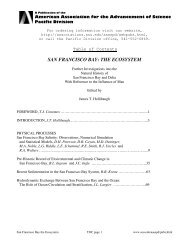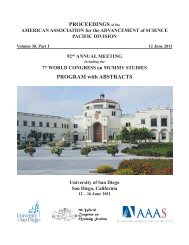Vol 31, Part I - forums.sou.edu ⢠Index page - Southern Oregon ...
Vol 31, Part I - forums.sou.edu ⢠Index page - Southern Oregon ...
Vol 31, Part I - forums.sou.edu ⢠Index page - Southern Oregon ...
You also want an ePaper? Increase the reach of your titles
YUMPU automatically turns print PDFs into web optimized ePapers that Google loves.
ABSTRACTS – Symposia<br />
Yersiniae. They promote adherence and internalization to<br />
epithelial cells, resistance to complement, and survival in<br />
macrophages. Even though well studied in enteric Yersiniae,<br />
their role in Y. pestis pathogenesis is unknown. To investigate<br />
the role of Y. pestis OmpX protein, an Ail homologue,<br />
we generated site-directed mutations in ompX and tested<br />
them for loss of any of these phenotypes. Our results demonstrated<br />
that OmpX was required for adherence and internalization<br />
to epithelial cells, and serum resistance. Infection<br />
studies revealed that loss of OmpX delayed the time-to-death<br />
in the mouse infection model of pneumonic plague. Because<br />
murine serum was not bactericidal for the ompX mutant, the<br />
mechanism underlying the delay in time-to-death in mice<br />
may be attributed to loss of adhesion/internalization properties,<br />
but not serum resistance. When OmpX virulence was<br />
assessed in the rat model complete attenuation of virulence<br />
was observed. This highlighted the critical role of serum<br />
resistance in primary pneumonic plague and showed its relevance<br />
for human disease. Additionally, our results showed<br />
that OmpX-mediated serum resistance, adhesiveness, and<br />
invasiveness were dependent on LPS core length, but recombinant<br />
OmpX displayed these functions in E. coli, independently<br />
of other Yersinia proteins and/or LPS. Overall, our<br />
data present an important contribution to understanding<br />
mechanisms of Y. pestis pathogenesis and their significance<br />
to human species.<br />
82 Construction and Characterization of Non-toxic Bacterial<br />
Enterotoxins as Vaccine Adjuvants, LAVANya VEMPATI*<br />
and Juliette Tinker (Department of Biological Sciences,<br />
Boise State University, Science/Nursing Building,<br />
Room 107, Boise, ID 82375; lavanyavempati@gmail.com).<br />
The development of adjuvants that can promote the<br />
delivery of purified subunit vaccines by mucosal routes,<br />
such as the nose or the mouth, is recognized as a top priority<br />
for vaccine research. The bacterial enterotoxins; cholera<br />
toxin (CT) and E.coli heat-labile toxin (LTI), have long<br />
been recognized as powerful adjuvants with the ability to<br />
stimulate specific immune responses to co-administered<br />
antigens when delivered to mucosal surfaces. Shiga toxin 1<br />
(ST1) and pertussis toxin (PT) are structurally homologous<br />
bacterial toxins secreted by Escherichia coli 0157:H7 and<br />
Bordetella pertussis respectively. ST1 and PT also have<br />
reported adjuvant activity. The receptor-binding affinity<br />
and protein stability of these AB5-type toxins appear to be<br />
the basis for their unique immunomodulatory properties.<br />
However, the toxicity of these molecules is a limiting factor<br />
for use as adjuvants in human vaccines. The non-toxic<br />
B subunit of CT, as well as chimeric A 2<br />
B molecules, have<br />
shown much promise as novel mucosal vaccine candidates.<br />
A 2<br />
B chimeras of CT retain the capacity to introduce antigens<br />
into host cells and modulate the immune response,<br />
and toxic domains are replaced with a vaccine antigen of<br />
interest. We have produced ST1 A 2<br />
B chimeras containing<br />
the Yersinia pestis bacterial antigen, LcrV and characterized<br />
antigen uptake in vitro by confocal microscopy. In<br />
addition, we have compared the ability of PTB, ST1B and<br />
CTB to stimulate cytokine production, dendritic cell proliferation<br />
and antigen uptake in vitro. These studies will contribute<br />
to the development of these toxins as novel mucosal<br />
adjuvants.<br />
83 Norovirus Genotype Dynamics Among Outbreak Associated<br />
Strains in Alaska, Idaho, Montana, and Wyoming 2010-<br />
2012, Amanda J Bruesch and CHRISTOPHER L<br />
Ball* (Idaho Bureau of Laboratories, 2220 Old Penitentiary<br />
Road, Boise, ID 83712; ballc1@dhw.idaho.gov).<br />
Noroviruses are thought to cause >90% of viral gastroenteritis<br />
outbreaks worldwide. Noroviruses are one of four<br />
genera in the Caliciviridae. They are categorized into five<br />
genogroups, GI – GV. Strains from genogroups GI, GII, and<br />
GIV are associated with human disease, with GII causing<br />
most outbreaks. Norovirus genogroup II is subdivided into<br />
17 genotypes. The Idaho Bureau of Laboratories provides<br />
Norovirus genotyping for Idaho, Alaska, Montana, and Wyoming<br />
outbreaks as part of the CDC’s national Norovirus subtyping<br />
network, CaliciNet USA.<br />
In 2010, regional Norovirus diversity was low (Simpsons<br />
D=0.28; S=5) with 84% of confirmed outbreaks attributed<br />
to Norovirus GII.4_NewOrleans. In 2011, genotypic<br />
diversity increased (D=0.76; S=7) and genotype GII.1 (32%)<br />
replaced GII.4_NewOrleans (26%) as the most abundant outbreak<br />
genotype. Norovirus evolution is driven by antigenic<br />
drift associated with the development of herd immunity. This<br />
data may suggest a shift in the infectivity of norovirus GII.4_<br />
NewOrleans and the emergence of a new epidemic strain in<br />
the Pacific Northwest.<br />
84 Campylobacter jejuni Exploits Host Cell Processes to<br />
Enhance Disease, Michael E Konkel (Washington<br />
State University, School of Molecular Biosciences, Life Sciences<br />
Bldg, Room 302c, Pullman, WA 99164-7520; konkel@vetmed.wsu.<strong>edu</strong>).<br />
Campylobacter species are one of the most common<br />
culture-proven causes of human gastrointestinal disease<br />
worldwide, accounting for 400 – 500 million cases of diarrhea<br />
each year. Acute illness is specifically associated with C.<br />
jejuni invasion of intestinal epithelial cells. Accompanying<br />
C. jejuni invasion of the intestinal epithelium is an intense<br />
inflammatory response characterized by the secretion of<br />
interleukin-8 (IL-8) from the epithelial cells. Previous work<br />
has shown that maximal invasion of host cells by C. jejuni is<br />
dependent on synthesis and secretion of proteins termed the<br />
Campylobacter invasion antigens (Cia). We hypothesized<br />
that C. jejuni promotes the activation of intestinal cell signaling<br />
cascades, leading to host cell actin cytoskeletal rearrangements<br />
and the secretion of IL-8. To test this hypothesis,<br />
we infected epithelial cells with a C. jejuni wild-type strain<br />
71








